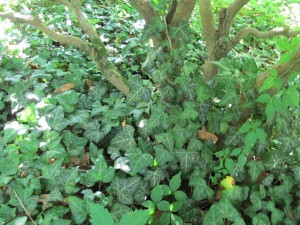Have you taken the “No Ivy Pledge”? I have not. In an effort to slow defections from growing ivy, the American Ivy Society has developed a list of non-invasive cultivars. It includes several dwarf English ivy cultivars (Hedera spp.). Add a little water and fertilizer and these mini-ivies do not miss a beat.
Mini- ivies are excellent performers in shaded areas and tolerate poor soils if well cared for with water and fertilizer in their first year in the garden. Their slow growth mode keeps them under control by most average gardeners. They tend to grow 1-3 inches per year and are little threat of becoming invasiveness.
According to the American Ivy Society, some of the best mini-ivies include: ‘Buttercup’, ‘Glacier’, ‘Golden Curl’, ‘Golden Ingot’, ‘Golden Starlight’, ‘Goldheart’, ‘Henriette’, ‘Ingrid’, ‘Itsy Bitsy’, ‘Jubilee’, ‘Lady Francis’, ‘Spetchley’, ‘Teardrop’, and ‘Willie’.
Ivy’s invasive stage starts when you allow the vegetative (juvenile) plant to flower and produce seeds (adulthood). Many ivy cultivars do not flower or seed when held in the juvenile vining stage on the ground, especially those growing in shade.
Adult ivy tends to flower only in bright sun. The vine becomes more shrub-like. Flowers form and subsequently berries, which are eaten by birds. The seeds are dispersed into woodlands, gardens, etc. This begins the invasive nature of ivy which can be avoided by keeping ivies growing on the ground and not in trees and shrubs.
For additional information on growing ivies, refer to the American Ivy Society website at: http/www.americanivysociety.com


 Posted in
Posted in 
